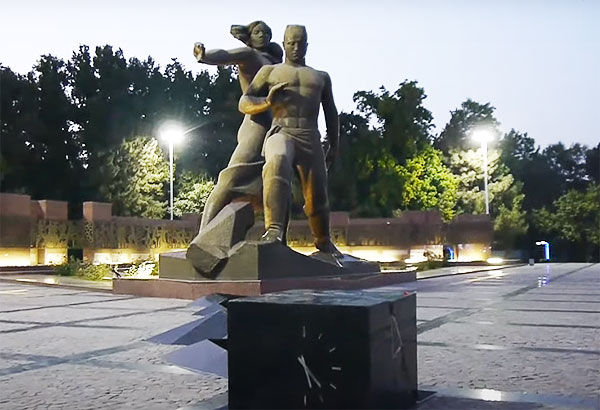10 years after the devastating earthquake in Tashkent, it was decided to build an architectural and artistic complex which was named "Courage", which, according to the plan of the architects, should embody the courage and patience of the people who went through the ordeals of the earthquake.
History
The earthquake broke out on April 26, 1966, early in the morning when Tashkent was sleeping. Aftershocks with a power of 8 points (on a 12-point scale) destroyed most of the city's buildings, most of which were adobe one-storeyed houses. The center of the city, so-called "Kashgarka", with residential districts of private traditional Uzbek houses, was practically wiped off the face of the earth. The epicenter was right under the city. According to seismologists, the consequences of the impact could have been much more severe if the epicenter was located deeper in the earth's crust. Due to the shallow epicenter about 5 kilometers below the surface, the earthquake was predominantly making vertical shock waves, the energy of which quickly dissipated. Thanks to this, many even clay buildings have retained their walls. In addition, large casualties among the population were luckily avoided.
Renovation of Tashkent
After the tragedy, the authorities of the USSR, of which Uzbekistan was a part at that time, made a call for restoration and began a large-scale program to renovate the capital of Uzbekistan. The look of the city has changed radically: instead of narrow winding streets and low-rise buildings, wide avenues and high-rise buildings, squares and parks have appeared.
 |
|
Courage Monument in Tashkent
|
In 1976, on the occasion of the 10th anniversary of the earthquake, the architectural and artistic complex "Courage" was erected to commemorate the revival from the 1966 Tashkent earthquake. It is located on the edge of a residential area that arose immediately after the earthquake to replace the completely destroyed old clay "Kashgarka" district.
Composition
The monument includes a sculptural composition of three people in the center, a black stone pedestal clock in the foreground, and a bas-relief pano in the background. A crack is winding through the black Labrador cube, splitting it in two. The clock shows the exact time and date of the disaster. The black crack runs further on the ground and reaches the sculpture - a man protecting a woman and a child behind her back from the disaster.
 |
|
View from the top
|
The symbol of the tragedies caused by the earthquake is a bronze plinth, made in the form of a complex broken line. The marble pedestal gives rise to seven paths in the form of beams leading to 14 stelae. The steles carry through bronze bas-reliefs depicting builders, soldiers, and volunteers who took part in the restoration of the city. Also, the steles symbolize the support provided to Uzbekistan by other republics of the Soviet Union.
Value of the Monument
The "Courage" monument is located in the very center of Tashkent, being one of favorite places for walks and festive events of its residents. Newlyweds come here to take photos of weddings and celebrations. In addition, the monument is an important element in excursions around Tashkent, being in turn, one of essential structural elements for tours in Uzbekistan. Local guides will tell tourists about the history of Tashkent, the 1966 earthquake, its consequences, and assistance that was provided in rebuilding the city, as well as how wonderfully Tashkent changed after this dramatic event.
 |
|
People resisting the earthquake
|
A magnificent shady park surrounding the Museum of Olympic Glory has developed around the monument and the nearby Ankhor Canal. On the other side of the canal, another Ankhor amusement park was recently laid out, where residents of the city and guests of the capital can see buildings that symbolize traditional national styles of different districts and regions of Uzbekistan. Also, they can enjoy the beauties of Tashkent from the cabin of the Ankhor Star Ferris wheel.
 |
|
Contribution to builders who restored the city
|





























